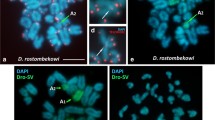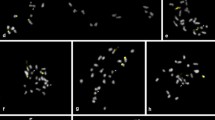Abstract
A whole-arm reciprocal translocation (WART) between the metacentric chromosomes af and hk is described for a single hybrid between chromosome races Drnholec and Łęgucki Młyn. This translocation resulted in the metacentric chromosomes ah and fk, previously unknown in Sorex araneus. This study provides a description of an unambiguous case of a WART in S. araneus, a phenomenon that has recently been suggested to play a significant role in generating of chromosome races in this species.

Similar content being viewed by others
Abbreviations
- WART:
-
whole-arm reciprocal translocation
References
Averianov AO ed. (2007) Proceedings of the ISACC’s Seventh International Meeting, St. Petersburg, Russia, 28 August 28–1 September, 2005. Russ J Theriol 6:1–122
Britton-Davidian J, Catalan J, Ramalhinho MG et al (2005) Chromosomal phylogeny of Roberstsonian races of the house mouse on the island of Madeira: testing between alternative mutational processes. Genet Res 86:171–183
Brünner H, Lugon-Moulin N, Hausser J (2002) Alps, genes, and chromosomes: their role in the formation of species in the Sorex araneus groups (Mammalia, Insectivora), as inferred from two hybrid zones. Cytogenet Genome Res 96:85–96
Capanna E, Redi CA (1995) Whole-arm reciprocal translocation (WART) between Robertsonian chromosomes: finding of a Robertsonian heterozygous mouse with karyotype derived through WARTs. Chromosome Res 3:135–137
Castiglia R, Capanna E (1999) Whole-arm reciprocal translocation (WART) in a feral population of mice. Chromosome Res 7:493–495
Fedyk S (1980) Chromosome polymorphism in a population of Sorex araneus L. at Białowieża. Folia Biol (Kraków) 28:83–120
Fedyk S (1995) Regional differentiation and hybrid zones between chromosomal races of Sorex araneus L. in north-eastern Poland [In Polish]. Dissertations Universitatis Varsoviensis 439:1–125 Białystok
Fedyk S, Chętnicki W, Banaszek A (1991) Genetic differentiation of Polish populations of Sorex araneus L III. Interchromosomal recombination in a hybrid zone. Evolution 45:1384–1392
Fedyk S, Banaszek A, Chętnicki W, Cichomska A, Szałaj KA (2000) Reassessment of the range of the Drnholec race: studies on meiosis in Sorex araneus hybrids. Acta Theriol 45(Suppl 1):59–67
Fedyk S, Wójcik JM, Chętnicki W, Mączewski S (2008) Invalidation of Stobnica chromosome race of the common shrew Sorex araneus. Acta Theriol 53:375–380
Ford CE (1964) Selection pressure in mammalian cell populations. In: Harris RJC (ed) Cytogenetics of cells in culture. symposia of the international society for cell biology 3. Academic Press, New York, pp 27–45
Ford CE, Hamerton JL (1970) Chromosome polymorphism in the common shrew, Sorex araneus. Symp Zool Soc Lond 26:223–236
Fredga K (1996) The chromosome races of Sorex araneus in Scandinavia. Hereditas 125:123–135
Fredga K (2003) Chromosome races of Sorex araneus in Norway. Description of two new races. Mammalia 68:179–185
Garagna S, Zuccotti M, Redi CA, Capanna E (1997) Trapping speciation. Nature 390:241–242
Halkka L, Söderlund V, Skarén U, Heikkilä J (1987) Chromosomal polymorphism and racial evolution of Sorex araneus L. in Finland. Hereditas 106:257–275
Halkka L, Vakula N, Kaikusalo A (1994) Revision of Sorex araneus L chromosome nomenclature, and race N new for Finland. Ann Zool Fennici 31:283–288
Hauffe HC, Pialek J (1997) Evolution of the chromosomal races of Mus musculus domesticus in the Rhaetian Alps: the roles of whole-arm reciprocal translocation and zonal raciation. Biol J Linn Soc 62:255–278
Meylan A, Hausser J (1973) Les chromosomes des Sorex du groupe araneus–arcticus (Mammalia, Insectivora). Z Sauget 38:143–158
Olert J, Schmid M (1978) Comparative analysis of karyotypes in European shrew species. I. The sibling species Sorex araneus and S. gemellus: Q-bands, G-bands and position of NORs. Cytogenet Cell Genet 20:308–322
Pavlova SV, Kolomiets OL, Bulatova NS, Searle JB (2008) Demonstration of a WART in a hybrid zone of the common shrew (Sorex araneus Linnaeus, 1758). Comp Cytogenet 2:115–120
Seabright M (1971) A rapid banding technique for human chromosomes. Lancet 2:971–972
Searle JB (1986) Factors responsible for a karyotypic polymorphism in the common shrew, Sorex araneus. Proc R Soc Lond [Biol] 229:277–298
Searle JB (1993) Chromosomal hybrid zones in eutherian mammals. In: Harrison RG (ed) Hybrid zones and the evolutionary process. Oxford, Oxford University Press, pp 309–353
Searle JB, Wójcik JM (1998) Chromosomal evolution: the case of Sorex araneus. In: Wójcik JM, Wolsan M (eds) Evolution of shrews. mammal research institute, PAS, Białowieża, pp 221–268
Searle JB, Fedyk S, Fredga K, Hausser J, Volobouev VT (1991) Nomenclature for the chromosomes of the common shrew (Sorex araneus). Mém Soc Vaud Sci Nat 19:13–22
Shaw DD, Wilkinson P, Coates DJ (1983) Increased chromosomal mutation rate after hybridization between two subspecies of grasshoppers. Science 220:1165–1167
Szałaj KA, Fedyk S, Banaszek A, Chętnicki W (1995) Maximization of the frequency of recombinants in the hybrid zones of Sorex araneus in northern Poland. Acta Theriol 40:225–236
Volobouev VT (1989) Phylogenetic relationships of the Sorex araneus–arcticus species complex (Insectivora, Soricidae) based on high-resolution chromosome analysis. J Hered 80:284–290
Wójcik JM, Borodin PM, Fedyk S et al (2003) The list of the chromosome races of the common shrew Sorex araneus (updated 2002). Mammalia 68:169–178
Zima J (1991) Banded chromosomes of the Sorex daphaenodon: a comparison with S. araneus (Mammalia, Insectivora). Mém Soc Vaud Sci Nat 19:119–124
Zima J, Wójcik JM, Horákova M (1988) The number of karyotypic variations in the common shrew (Sorex araneus). Acta Theriol 33:467–475
Acknowledgements
We are grateful to Professor J. B. Searle and Dr. P. D. Polly for valuable comments and improving our English. We also thank two anonymous reviewers for helpful comments on the manuscript as well as P. Rode MSc for his assistance in trapping shrews. The study was supported by the Polish State Committee for Scientific Research within the grants 6 P204 034 05 and 6 PO4c 035 15.
Author information
Authors and Affiliations
Corresponding author
Additional information
Responsible Editor: Herbert Macgregor
This article is dedicated to Professor Alina Myrcha, founder and former director of Institute of Biology, University of Białystok, to commemorate her retirement.
Rights and permissions
About this article
Cite this article
Fedyk, S., Chętnicki, W. Whole-arm reciprocal translocation in a hybrid population of Sorex araneus . Chromosome Res 17, 451–454 (2009). https://doi.org/10.1007/s10577-009-9036-z
Received:
Revised:
Accepted:
Published:
Issue Date:
DOI: https://doi.org/10.1007/s10577-009-9036-z




